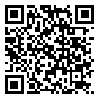Volume 2, Issue 2 (10-2012)
MEJDS (2012) 2: 45 |
Back to browse issues page
Download citation:
BibTeX | RIS | EndNote | Medlars | ProCite | Reference Manager | RefWorks
Send citation to:



BibTeX | RIS | EndNote | Medlars | ProCite | Reference Manager | RefWorks
Send citation to:
Nosratinejad F, Akhavan Behbahani A, Dayhol M. Beggary in Iran: Practices, Trends and Causes. MEJDS 2012; 2 (2) :45-54
URL: http://jdisabilstud.org/article-1-304-en.html
URL: http://jdisabilstud.org/article-1-304-en.html
Abstract: (18037 Views)
Objective: Beggary is a commom phenomenon in many urban areas that has unpleasant social implications. This study attempted to demonstrate an image of beggary and its forms in Iran and to explain it.
Methods: This study relied on secondary analysis of data collected on beggars in 2007–2010 in Iran. Moreover, meta-analysis of some of the most important studies conducted in Iran during the years 1991–2008 was also done.
Results: According to the results most of the beggars (approximately 68%) are male. The proportion of beggars younger than 20 years has increased in recent years. However, most of them are 40 and above. Furthermore, the proportion of illiterate groups has greatly decreased and has fallen from 80.7% in 1991 to 28.1% in 2007. Single beggars have also increased in number, although the majority of beggars are still married. The percentage of disabled beggars has also decreased, though many of them use disability as a means of gaining sympathy.
Conclusion: In general, beggary is still a male phenomenon in Iran, the main causes of which are poverty and unemployment. Thus creating job opportunities for men is very important, given that usually beggars are married, not single. The rise in numbers of un-maimed beggars is another indication that poverty & unemployment encourage beggary. Nevertheless, it should be noted that some beggars see begging as a lucrative profession, and therefore are not willing to abandon it easily and even feign disability to increase their income.
Methods: This study relied on secondary analysis of data collected on beggars in 2007–2010 in Iran. Moreover, meta-analysis of some of the most important studies conducted in Iran during the years 1991–2008 was also done.
Results: According to the results most of the beggars (approximately 68%) are male. The proportion of beggars younger than 20 years has increased in recent years. However, most of them are 40 and above. Furthermore, the proportion of illiterate groups has greatly decreased and has fallen from 80.7% in 1991 to 28.1% in 2007. Single beggars have also increased in number, although the majority of beggars are still married. The percentage of disabled beggars has also decreased, though many of them use disability as a means of gaining sympathy.
Conclusion: In general, beggary is still a male phenomenon in Iran, the main causes of which are poverty and unemployment. Thus creating job opportunities for men is very important, given that usually beggars are married, not single. The rise in numbers of un-maimed beggars is another indication that poverty & unemployment encourage beggary. Nevertheless, it should be noted that some beggars see begging as a lucrative profession, and therefore are not willing to abandon it easily and even feign disability to increase their income.
Type of Study: Original Research Article |
Subject:
Rehabilitation
Send email to the article author
| Rights and permissions | |
 |
This work is licensed under a Creative Commons Attribution-NonCommercial 4.0 International License. |




